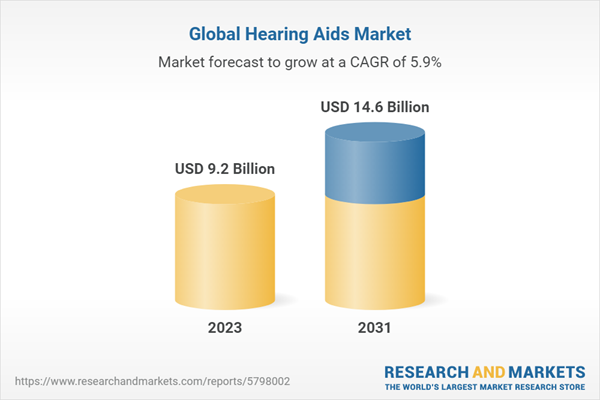Hearing Aids: Introduction
Hearing aids are small electronic devices designed to improve hearing and communication abilities for individuals with hearing loss. They consist of a microphone, an amplifier, a speaker, and a power source (typically a battery). Hearing aids can be worn behind the ear, in the ear canal, or as a small device attached to the ear's outer rim, depending on the design and specific needs of the user.The applications of hearing aids are as follows:
- Amplification of sound: The primary function of a hearing aid is to amplify sound, making it easier for individuals with hearing loss to hear and understand speech and other environmental noises
- Improved speech comprehension: By increasing the volume of speech sounds relative to background noise, hearing aids can help users better comprehend conversations in various settings, such as at home, work, or social gatherings
- Enhanced quality of life: Hearing aids can significantly improve the overall quality of life for individuals with hearing loss, enabling them to participate more fully in social activities and maintain better communication with friends and family
- Tinnitus management: For some individuals, hearing aids can help alleviate the symptoms of tinnitus (ringing or buzzing in the ears) by providing sound amplification, which may mask or reduce the perception of tinnitus
- Connection to assistive devices: Modern hearing aids often come equipped with wireless connectivity options, allowing users to connect them to smartphones, televisions, and other devices for a more seamless listening experience. This feature can be particularly beneficial for users who rely on assistive listening devices in educational, professional, or recreational settings
Hearing Aids Market Segmentations
The market can be categorised into product type, technology, type of hearing loss, population type, treatment channel, end user, and region.Market Breakup by Product Type
- In-the-Ear Hearing Aids
- Receiver-In-the-Ear Hearing Aids
- Behind-the-Ear Hearing Aids
- Canal Hearing Aids
Market Breakup by Technology
- Digital Hearing Aids
- Analog Hearing Aids
Market Breakup by Type of Hearing Loss
- Sensorineural Hearing Loss
- Conductive Hearing Loss
- Mix Hearing Loss
Market Breakup by Population Type
- Child
- Adults
- Male
- Female
- Geriatrics
- Male
- Female
Market Breakup by Treatment Channel
- Public
- Private
Market Breakup by End User
- Hospitals
- Otology Clinics
- Ambulatory Clinics
- Others
Hearing Aids Market Breakup by Region
North America
- United States of America
- Canada
Europe
- United Kingdom
- Germany
- France
- Italy
- Others
Asia Pacific
- China
- Japan
- India
- ASEAN
- Australia
- Others
Latin America
- Brazil
- Argentina
- Mexico
- Others
Middle East and Africa
- Saudi Arabia
- United Arab Emirates
- Nigeria
- South Africa
- Others
Hearing Aids Market Scenario
The global hearing aids market is experiencing robust growth, driven by factors such as an ageing population, increased prevalence of hearing loss, technological advancements, and rising awareness about the importance of early diagnosis and treatment. The market has witnessed a shift towards more discreet, comfortable, and technologically advanced devices, such as invisible-in-canal hearing aids and devices with wireless connectivity. These innovations have improved user experience and broadened the appeal of hearing aids to a wider range of individuals.Additionally, the emergence of tele audiology and mobile applications has further enhanced access to hearing care services, particularly in remote and underserved areas. Government initiatives and the expansion of public health programs have also contributed to increased adoption of hearing aids worldwide. Key players in the market are focusing on research and development, strategic partnerships, and mergers and acquisitions to strengthen their product portfolios and expand their global presence. The hearing aids market is expected to continue its upward trajectory, driven by the growing demand for innovative, effective, and accessible solutions for hearing loss.
Key Players in the Global Hearing Aids Market
The report gives an in-depth analysis of the key players involved in the hearing aids market, sponsors manufacturing the drugs, and putting them through trials to get FDA approvals. The companies included in the market are as follows:- Abbott
- WIDEX A/S
- GN Store Nord A/S
- Sonova
- Sivantos
- Microson
- Horentek
- RION CO. Ltd
- Demant A/S
- Amplifon
- Starkey
- MED-EL Medical Electronics
- Cochlear Ltd
- SeboTek Hearing Systems, LLC
- Audina Hearing Instruments, Inc
- Arphi Electronics Private Limited
- Sound One India
- Amplicon
- MED-EL Medical Electronics (Austria)
Table of Contents
Companies Mentioned
- Abbott
- Widex A/S
- Gn Store Nord A/S
- Sonova
- Sivantos
- Microson
- Horentek
- Rion Co. Ltd
- Demant A/S
- Amplifon
- Starkey
- Med-El Medical Electronics
- Cochlear Ltd.
- Sebotek Hearing Systems, LLC.
- Audina Hearing Instruments, Inc.
- Arphi Electronics Private Limited
- Sound One India
- Amplicon
- Med-El Medical Electronics (Austria)
Table Information
| Report Attribute | Details |
|---|---|
| No. of Pages | 140 |
| Published | May 2023 |
| Forecast Period | 2023 - 2031 |
| Estimated Market Value ( USD | $ 9.2 Billion |
| Forecasted Market Value ( USD | $ 14.6 Billion |
| Compound Annual Growth Rate | 5.9% |
| Regions Covered | Global |
| No. of Companies Mentioned | 19 |









